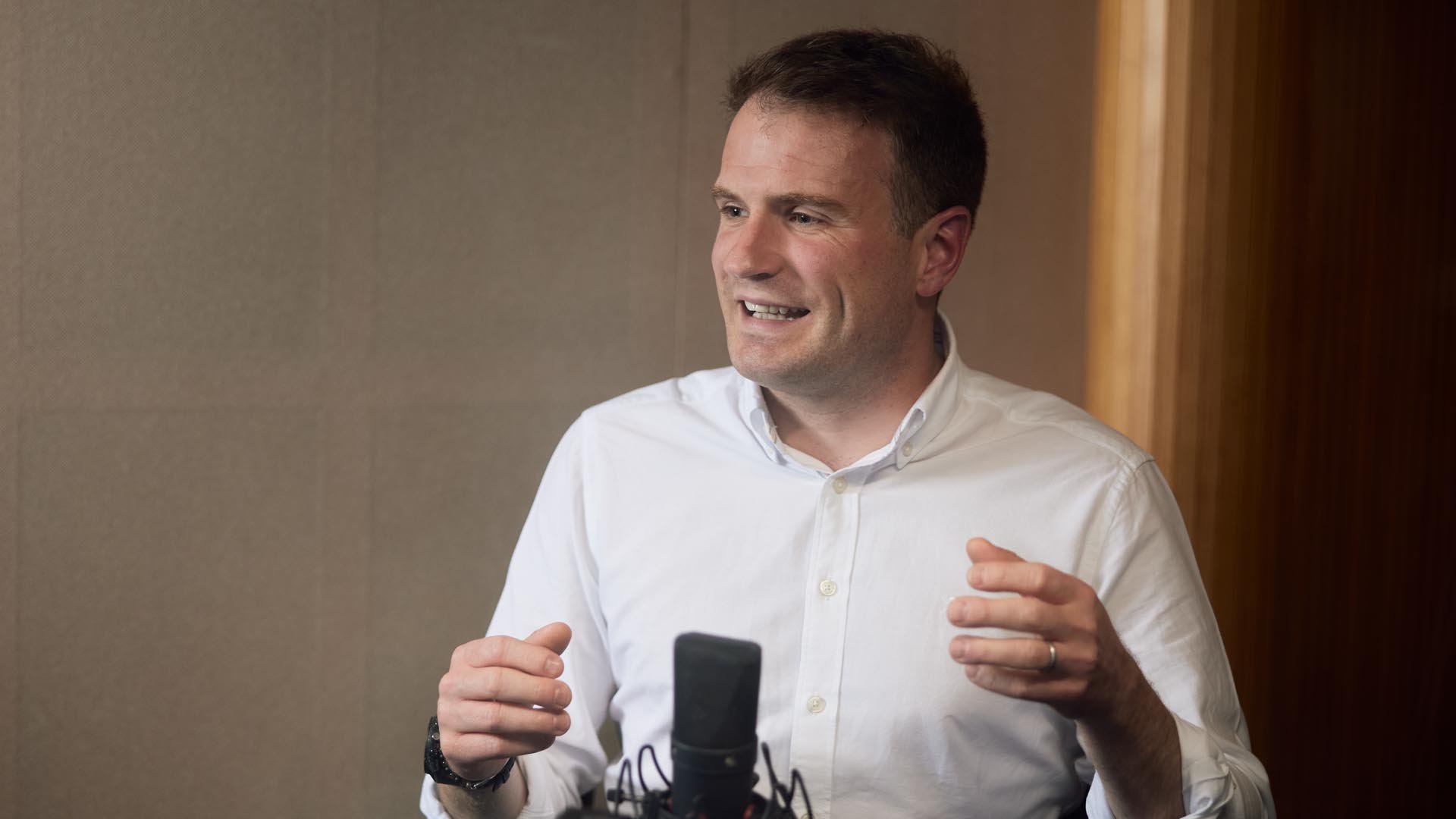
All investment strategies have the potential for profit and loss, your capital may be at risk.
There has never been a period like 2020–2023. First a global lockdown, then a difficult reopening, set against an increasingly troubled geopolitical backdrop. Volatility in global markets reflected the instability and uncertainty of the times.
Whatever the backdrop, Edinburgh Worldwide Investment Trust (EWIT) looks for a special subset of companies: those at an early stage with the potential to disrupt their industries. As a high-growth style applied to the most innovative part of the market, it’s not an approach we can easily change when volatility strikes. Nor would we want to.
It has made for a bruising few years, but the experience has brought the Trust’s managers closer together as a team and galvanised elements of our philosophy and process.
As markets gyrated around us, we chose to stand firm. While sticking to our knitting, we challenged ourselves even harder on why we want to own a particular company. And we kept faith with our ‘four traits’ framework: looking for innovation against unmet problems, competitive advantage, quality of management and intrinsic scalability.
A universe of opportunity ahead
Does the end of an era of cheap money pose an existential threat to the Trust’s approach? The question has been asked because the funding of early-stage businesses has changed: decision makers now have a higher threshold for committing to deploy capital. But this doesn’t undermine the strategy or meaningfully diminish the future opportunity.
We continue to think ambitious companies will ultimately be rewarded, regardless of the funding environment. Capital tends to find its way to the firms with the best answers to society’s problems. But with the stock market currently preferring near-term resilience to long-term relevance, businesses on that longer trajectory must show more robustness.
Increasingly they will need the funding and balance sheet strength to fulfil their promise over many years. Therefore, we now look for companies to show skill at capital allocation.
EWIT’s interest in promising early-stage companies is well-known but it’s worth stressing our equal desire still to be owning these problem-solving, innovative companies when they come to deliver.
The portfolio contains a wide spectrum of company maturities, including some that the team has owned for 10 years or more which have largely de-risked their core products and solutions. There’s still significant potential, however, for these businesses to run further, which is why companies such as Alnylam and Axon Enterprise, and emerging incumbents such as MarketAxess remain as significant positions in the portfolio. These aren’t staid old companies that have been around for decades, but companies now becoming dominant franchises in areas of enduring structural opportunity.
That’s what excites us. We ask how these companies can use their emerging incumbency, and associated financial strength, to turbocharge growth and deepen competitive advantage in a new period of relative belt-tightening.
Scarcity may increase the appeal of many holdings. We look for companies whose solutions are both better and cheaper than the status quo. A handful of software holdings are helping businesses do more with less, driving productivity.
Blackline’s cloud accounting software allows financial managers to automate and streamline record-keeping and make informed decisions more easily. Appian’s code library can be bolted on to companies’ systems to build bespoke applications, automating time-consuming processes. The added value offered far outstrips their relatively small subscription fees. These propositions become more compelling when everyone is focussed on cost.
Besides benefitting from the reductions in unit costs of key enabling technologies, some of our companies are contributing to those reductions.
Oxford Nanopore’s low-cost sequencing technology, which can interrogate DNA with unprecedented precision, is positioned to transform the application of genomics in both scientific research and clinical decision-making.

SpaceX Starship launch. © SpaceX
SpaceX, owned as a private company, is well known now but when we first invested it was much more doubtful that you could launch thousands of satellites to provide broadband access practically everywhere. It’s delivering attractive returns while slashing the cost of access to these technologies and driving a massively deflationary trend.
Rather than fixating on any singular trend, be they based on Moore’s law or its genomic equivalent the Carlson Curve, we watch how such developments interact.
The most interesting businesses are those with their finger on the pulse of multiple technologies who are integrating them in ways others struggle to replicate. The root of their competitive edge is the convergence of technologies and the interdisciplinary skills they amass.
Oxford Nanopore’s edge over competitors is made up of expertise in numerous distinct domains: semiconductors, protein biochemistry, sensor technology and machine learning algorithms to interpret the signal. That combination is hard to replicate.
Alternatively, consider Axon Enterprise, which combines expertise in vision sensors and AI to accelerate evidence collection and analysis. Or Ocado, which is using robotics and machine learning expertise to bring down prices in logistics and formerly labour-intensive fulfilment centres.
More surprising is that, even as a team that monitors the expanding frontiers of innovation, we’re still coming across companies doing things that even a few years ago we wouldn’t have thought possible.
US drug discovery software company Schrodinger is a good example here. The idea that a computer could design a drug from scratch would once have seemed preposterous, given the intricacies of how drugs work within the body and the number of variables involved. Schrodinger has effectively decoded the rules of molecular physics by harnessing modern computational power.
Advances such as this attest to the constant refreshing of EWIT’s opportunity set. We never feel we’re running out of opportunity to invest in companies shaping the future.
Why invest now?
There are two answers to this question. One concerns our view on current valuations, the other is based on our enduring rational optimism about technology-driven innovators and companies.
There’s no doubt our part of the market has been hard hit by recent price falls. We’re long-term growth investors, so we would never trade on our ability to time markets. We’ve always seen the tremendous potential for upside in these immature businesses, but it does currently seem that investors with the right horizons could see these benefits accentuated.
We’re more confident than ever in the structural opportunity – and that it remains timeless. Despite market concern about macroeconomics and geopolitics, our long-term philosophy has never been more relevant.
Yes, there are reasons for angst, but there always will be. More importantly, there will always be a plethora of problems to be solved, and innovators with the ingenuity to tackle them, using tools that are improving exponentially. That’s the real opportunity EWIT looks to exploit. It’s a recipe for long-term value creation.
While doom and gloom will always be with us, looking back over the long term, innovation and progress have tended to surprise more on the upside. That’s what the great Swedish statistician Hans Rosling, who backed his optimism with hard data, described as ‘the secret silent miracle of human progress’.
Risk factors and important information
The views expressed should not be considered as advice or a recommendation to buy, sell or hold a particular investment. They reflect opinion and should not be taken as statements of fact, nor should any reliance be placed on them when making investment decisions.
This communication was produced and approved in November 2023 and has not been updated subsequently. It represents views held at the time of writing and may not reflect current thinking.
All investment strategies have the potential for profit and loss, your capital may be at risk. Past performance is not a guide to future returns.
This article does not constitute, and is not subject to the protections afforded to, independent research. Baillie Gifford and its staff may have dealt in the investments concerned. The views expressed are not statements of fact and should not be considered as advice or a recommendation to buy, sell or hold a particular investment.
Baillie Gifford & Co and Baillie Gifford & Co Limited are authorised and regulated by the Financial Conduct Authority (FCA). The investment trusts managed by Baillie Gifford & Co Limited are listed on the London Stock Exchange and are not authorised or regulated by the FCA.
A Key Information Document is available at bailliegifford.com.
All information is sourced from Baillie Gifford & Co and is current unless otherwise stated.
The images used in this communication are for illustrative purposes only.
The investment trusts managed by Baillie Gifford & Co Limited are listed UK companies. The value of their shares, and any income from them, can fall as well as rise and investors may not get back the amount invested.
The Trust invests in overseas securities. Changes in the rates of exchange may also cause the value of your investment (and any income it may pay) to go down or up.
Unlisted investments such as private companies, in which the Trust has a significant investment, can increase risk. These assets may be more difficult to sell, so changes in their prices may be greater.
The Trust can borrow money to make further investments (sometimes known as “gearing” or “leverage”). The risk is that when this money is repaid by the Trust, the value of the investments may not be enough to cover the borrowing and interest costs, and the Trust will make a loss. If the Trust’s investments fall in value, any invested borrowings will increase the amount of this loss.
Market values for securities which have become difficult to trade may not be readily available and there can be no assurance that any value assigned to such securities will accurately reflect the price the Trust might receive upon their sale.
The Trust can make use of derivatives which may impact on its performance.
Investment in smaller, immature companies is generally considered higher risk as changes in their share prices may be greater and the shares may be harder to sell. Smaller, immature companies may do less well in periods of unfavourable economic conditions.
Share prices may either be below (at a discount) or above (at a premium) the net asset value (NAV). The Company may issue new shares when the price is at a premium which may reduce the share price. Shares bought at a premium may have a greater risk of loss than those bought at a discount.
The Trust can buy back its own shares. The risks from borrowing, referred to above, are increased when a trust buys back its own shares.
The aim of the Trust is to achieve capital growth. You should not expect a significant, or steady, annual income from the Trust.
The Trust is listed on the London Stock Exchange and is not authorised or regulated by the Financial Conduct Authority.
Ref: 77122 10040793





